Operations and Project Management
VerifiedAdded on 2022/12/23
|12
|3815
|54
AI Summary
This study material covers the principles of operations management and project management. It includes a comparison between operation and operations management, implementation of operations management principles, continuous improvement principles, and a case study on project life cycle.
Contribute Materials
Your contribution can guide someone’s learning journey. Share your
documents today.
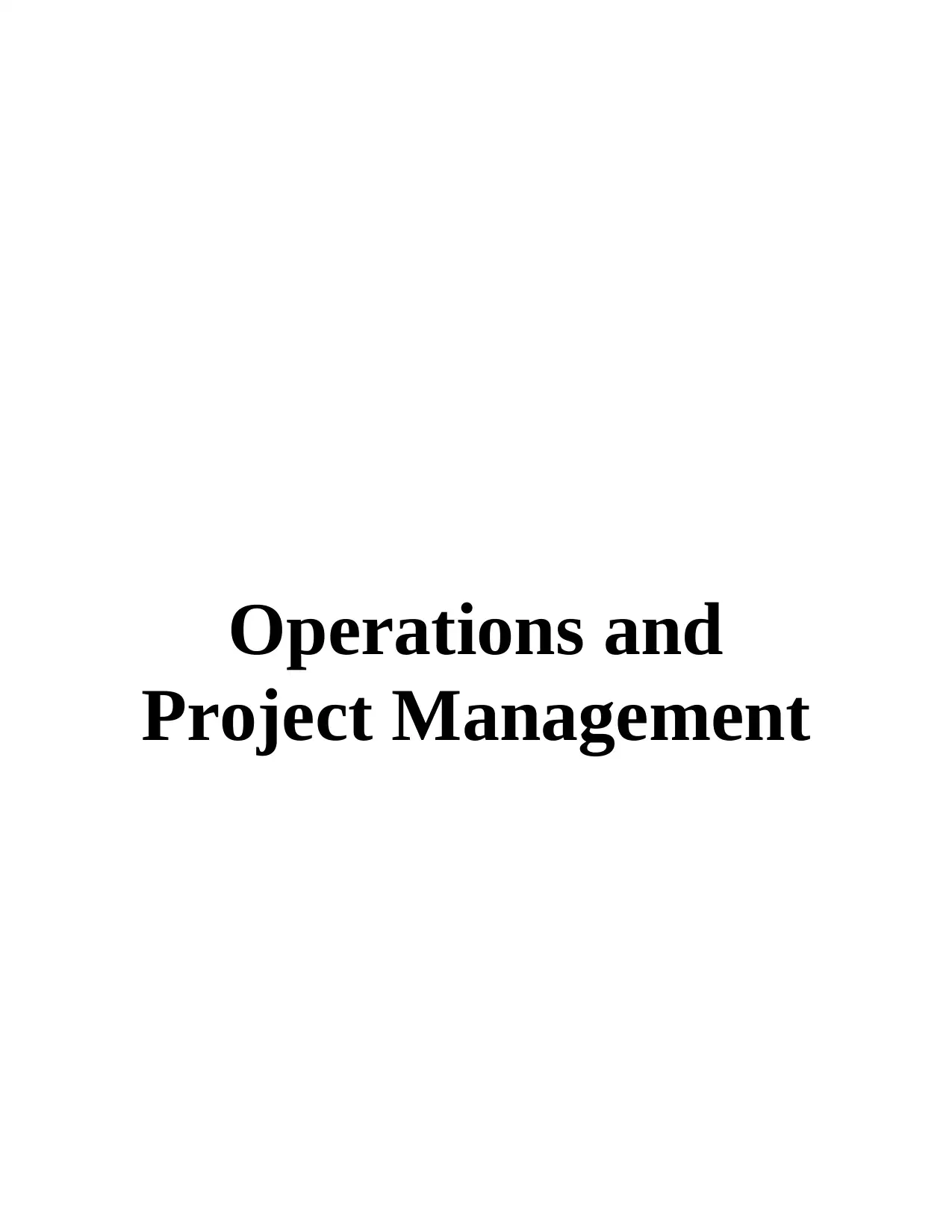
Operations and
Project Management
Project Management
Secure Best Marks with AI Grader
Need help grading? Try our AI Grader for instant feedback on your assignments.

Table of Contents
INTRODUCTION...........................................................................................................................3
SECTION-A....................................................................................................................................3
1 .About the organisation.......................................................................................................3
2 .Operation vs operations management................................................................................3
3 .Review and critique of the implementation of operations management principles on
organisation............................................................................................................................4
4 .Analyse the extent to which the operations management of the organisation in the case
study meets the requirements of the organisation..................................................................4
5 . Discuss continuous improvement as a philosophy and describe the Lean principles. .....4
6 .Prepare continuous improvement plan based on your review and critique of operations
management principles...........................................................................................................5
7 .Recommendations that improve the operations function using continuous improvement
principles................................................................................................................................6
SECTION-B.....................................................................................................................................6
1 .An overview of the case study............................................................................................6
2 .A description of the PLC and its stages..............................................................................7
3 .Business case......................................................................................................................7
4 .Critical analysis of the rationale for the project methodologies, tools and leadership
methods you have implemented within the PLC for your project..........................................9
5 .Evaluation of the effectiveness of the PLC and differentiation between large and small-
scale projects in respect to PLC..............................................................................................9
CONCLUSION..............................................................................................................................10
REFERENCE.................................................................................................................................11
INTRODUCTION...........................................................................................................................3
SECTION-A....................................................................................................................................3
1 .About the organisation.......................................................................................................3
2 .Operation vs operations management................................................................................3
3 .Review and critique of the implementation of operations management principles on
organisation............................................................................................................................4
4 .Analyse the extent to which the operations management of the organisation in the case
study meets the requirements of the organisation..................................................................4
5 . Discuss continuous improvement as a philosophy and describe the Lean principles. .....4
6 .Prepare continuous improvement plan based on your review and critique of operations
management principles...........................................................................................................5
7 .Recommendations that improve the operations function using continuous improvement
principles................................................................................................................................6
SECTION-B.....................................................................................................................................6
1 .An overview of the case study............................................................................................6
2 .A description of the PLC and its stages..............................................................................7
3 .Business case......................................................................................................................7
4 .Critical analysis of the rationale for the project methodologies, tools and leadership
methods you have implemented within the PLC for your project..........................................9
5 .Evaluation of the effectiveness of the PLC and differentiation between large and small-
scale projects in respect to PLC..............................................................................................9
CONCLUSION..............................................................................................................................10
REFERENCE.................................................................................................................................11
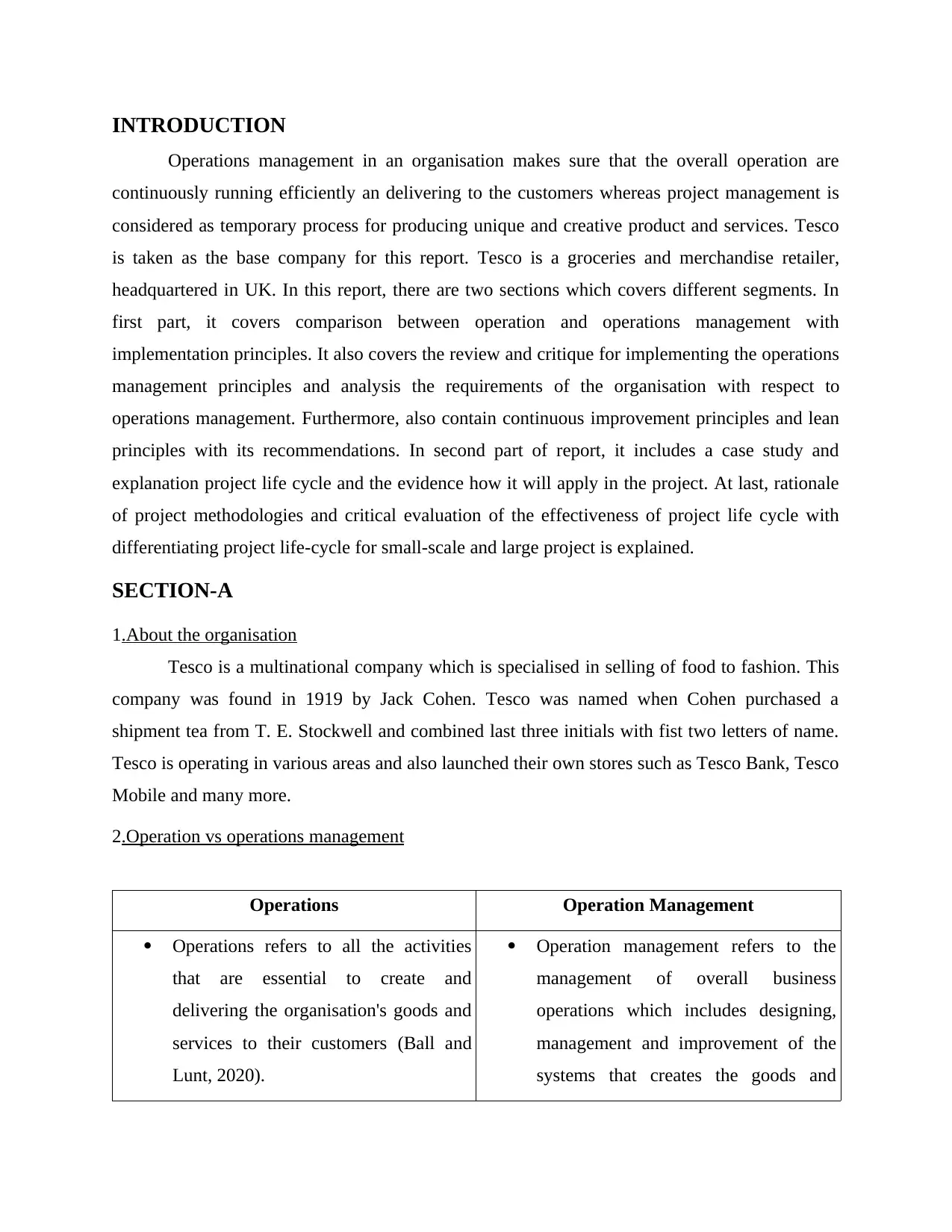
INTRODUCTION
Operations management in an organisation makes sure that the overall operation are
continuously running efficiently an delivering to the customers whereas project management is
considered as temporary process for producing unique and creative product and services. Tesco
is taken as the base company for this report. Tesco is a groceries and merchandise retailer,
headquartered in UK. In this report, there are two sections which covers different segments. In
first part, it covers comparison between operation and operations management with
implementation principles. It also covers the review and critique for implementing the operations
management principles and analysis the requirements of the organisation with respect to
operations management. Furthermore, also contain continuous improvement principles and lean
principles with its recommendations. In second part of report, it includes a case study and
explanation project life cycle and the evidence how it will apply in the project. At last, rationale
of project methodologies and critical evaluation of the effectiveness of project life cycle with
differentiating project life-cycle for small-scale and large project is explained.
SECTION-A
1.About the organisation
Tesco is a multinational company which is specialised in selling of food to fashion. This
company was found in 1919 by Jack Cohen. Tesco was named when Cohen purchased a
shipment tea from T. E. Stockwell and combined last three initials with fist two letters of name.
Tesco is operating in various areas and also launched their own stores such as Tesco Bank, Tesco
Mobile and many more.
2.Operation vs operations management
Operations Operation Management
Operations refers to all the activities
that are essential to create and
delivering the organisation's goods and
services to their customers (Ball and
Lunt, 2020).
Operation management refers to the
management of overall business
operations which includes designing,
management and improvement of the
systems that creates the goods and
Operations management in an organisation makes sure that the overall operation are
continuously running efficiently an delivering to the customers whereas project management is
considered as temporary process for producing unique and creative product and services. Tesco
is taken as the base company for this report. Tesco is a groceries and merchandise retailer,
headquartered in UK. In this report, there are two sections which covers different segments. In
first part, it covers comparison between operation and operations management with
implementation principles. It also covers the review and critique for implementing the operations
management principles and analysis the requirements of the organisation with respect to
operations management. Furthermore, also contain continuous improvement principles and lean
principles with its recommendations. In second part of report, it includes a case study and
explanation project life cycle and the evidence how it will apply in the project. At last, rationale
of project methodologies and critical evaluation of the effectiveness of project life cycle with
differentiating project life-cycle for small-scale and large project is explained.
SECTION-A
1.About the organisation
Tesco is a multinational company which is specialised in selling of food to fashion. This
company was found in 1919 by Jack Cohen. Tesco was named when Cohen purchased a
shipment tea from T. E. Stockwell and combined last three initials with fist two letters of name.
Tesco is operating in various areas and also launched their own stores such as Tesco Bank, Tesco
Mobile and many more.
2.Operation vs operations management
Operations Operation Management
Operations refers to all the activities
that are essential to create and
delivering the organisation's goods and
services to their customers (Ball and
Lunt, 2020).
Operation management refers to the
management of overall business
operations which includes designing,
management and improvement of the
systems that creates the goods and
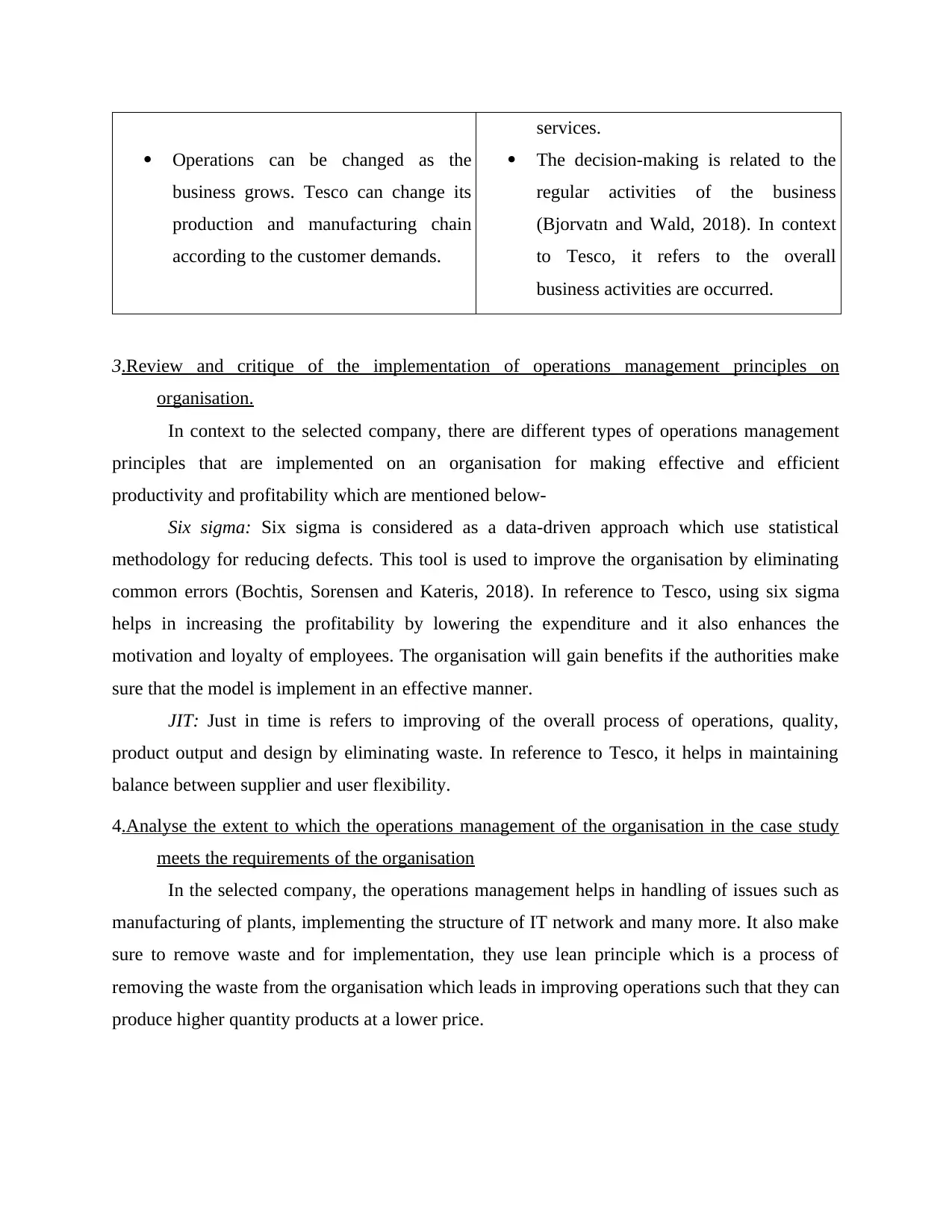
Operations can be changed as the
business grows. Tesco can change its
production and manufacturing chain
according to the customer demands.
services.
The decision-making is related to the
regular activities of the business
(Bjorvatn and Wald, 2018). In context
to Tesco, it refers to the overall
business activities are occurred.
3.Review and critique of the implementation of operations management principles on
organisation.
In context to the selected company, there are different types of operations management
principles that are implemented on an organisation for making effective and efficient
productivity and profitability which are mentioned below-
Six sigma: Six sigma is considered as a data-driven approach which use statistical
methodology for reducing defects. This tool is used to improve the organisation by eliminating
common errors (Bochtis, Sorensen and Kateris, 2018). In reference to Tesco, using six sigma
helps in increasing the profitability by lowering the expenditure and it also enhances the
motivation and loyalty of employees. The organisation will gain benefits if the authorities make
sure that the model is implement in an effective manner.
JIT: Just in time is refers to improving of the overall process of operations, quality,
product output and design by eliminating waste. In reference to Tesco, it helps in maintaining
balance between supplier and user flexibility.
4.Analyse the extent to which the operations management of the organisation in the case study
meets the requirements of the organisation
In the selected company, the operations management helps in handling of issues such as
manufacturing of plants, implementing the structure of IT network and many more. It also make
sure to remove waste and for implementation, they use lean principle which is a process of
removing the waste from the organisation which leads in improving operations such that they can
produce higher quantity products at a lower price.
business grows. Tesco can change its
production and manufacturing chain
according to the customer demands.
services.
The decision-making is related to the
regular activities of the business
(Bjorvatn and Wald, 2018). In context
to Tesco, it refers to the overall
business activities are occurred.
3.Review and critique of the implementation of operations management principles on
organisation.
In context to the selected company, there are different types of operations management
principles that are implemented on an organisation for making effective and efficient
productivity and profitability which are mentioned below-
Six sigma: Six sigma is considered as a data-driven approach which use statistical
methodology for reducing defects. This tool is used to improve the organisation by eliminating
common errors (Bochtis, Sorensen and Kateris, 2018). In reference to Tesco, using six sigma
helps in increasing the profitability by lowering the expenditure and it also enhances the
motivation and loyalty of employees. The organisation will gain benefits if the authorities make
sure that the model is implement in an effective manner.
JIT: Just in time is refers to improving of the overall process of operations, quality,
product output and design by eliminating waste. In reference to Tesco, it helps in maintaining
balance between supplier and user flexibility.
4.Analyse the extent to which the operations management of the organisation in the case study
meets the requirements of the organisation
In the selected company, the operations management helps in handling of issues such as
manufacturing of plants, implementing the structure of IT network and many more. It also make
sure to remove waste and for implementation, they use lean principle which is a process of
removing the waste from the organisation which leads in improving operations such that they can
produce higher quantity products at a lower price.
Secure Best Marks with AI Grader
Need help grading? Try our AI Grader for instant feedback on your assignments.

5. Discuss continuous improvement as a philosophy and describe the Lean principles.
Lean principle is a model that helps in managing the team in industries such as
manufacturing, construction and many more. Continuous improvement seeks in improving
process in the organisation by enhancing the activities that generate value for customer while
removing the waste. It also helps in employees satisfaction and teamwork and improving
customer satisfaction (Brickey and et. al., 2020). In context to Tesco, they use 5 principles that
are build on each other and create cycle for improvement which are mentioned below-
Value: In context to Tesco, this is the first principle which will determine and evaluate
the customer needs by conducting analysis.
Value steam: Value steam is the identification of all the functions and activities that are
required in completing the task or project. Manager of Tesco determine the areas of errors and
try to reduce them which helps in saving the resources of the company.
Flow: This principle is used in improvement in the flow by reducing the waste. Tesco
makes sure that flow of work are running smoothly without any hurdles.
Pull: In context to the selected organisation, pull approach determines that nothing can be
manufacture until the customer orders it. It is also required to establish communication approach
at every step of vale chain.
Perfection: The team seeks perfection after the team identifies areas of improvement and
implementing changes. Tesco analyse and focus on each process that increases the elements of
value and eliminating other thing which are not required.
6.Prepare continuous improvement plan based on your review and critique of operations
management principles
Continuous improvement plan:Continuous improvement approach is used in determining
the opportunities for the improvement which can help in achieving the goals of organisation for
increasing the profitability and also helps in enhancing the quality of products. In context to the
selected organisation, this plan include 4 process that are mentioned below-
Plan: In this phase, the selected organisation establish their objectives and processes that
are necessary for delivering the results (Dandage, Rane and Mantha, 2021). It will measures the
current standards and came up with ideas for improvement. Then it helps in creating plan for the
improvement and action.
Lean principle is a model that helps in managing the team in industries such as
manufacturing, construction and many more. Continuous improvement seeks in improving
process in the organisation by enhancing the activities that generate value for customer while
removing the waste. It also helps in employees satisfaction and teamwork and improving
customer satisfaction (Brickey and et. al., 2020). In context to Tesco, they use 5 principles that
are build on each other and create cycle for improvement which are mentioned below-
Value: In context to Tesco, this is the first principle which will determine and evaluate
the customer needs by conducting analysis.
Value steam: Value steam is the identification of all the functions and activities that are
required in completing the task or project. Manager of Tesco determine the areas of errors and
try to reduce them which helps in saving the resources of the company.
Flow: This principle is used in improvement in the flow by reducing the waste. Tesco
makes sure that flow of work are running smoothly without any hurdles.
Pull: In context to the selected organisation, pull approach determines that nothing can be
manufacture until the customer orders it. It is also required to establish communication approach
at every step of vale chain.
Perfection: The team seeks perfection after the team identifies areas of improvement and
implementing changes. Tesco analyse and focus on each process that increases the elements of
value and eliminating other thing which are not required.
6.Prepare continuous improvement plan based on your review and critique of operations
management principles
Continuous improvement plan:Continuous improvement approach is used in determining
the opportunities for the improvement which can help in achieving the goals of organisation for
increasing the profitability and also helps in enhancing the quality of products. In context to the
selected organisation, this plan include 4 process that are mentioned below-
Plan: In this phase, the selected organisation establish their objectives and processes that
are necessary for delivering the results (Dandage, Rane and Mantha, 2021). It will measures the
current standards and came up with ideas for improvement. Then it helps in creating plan for the
improvement and action.
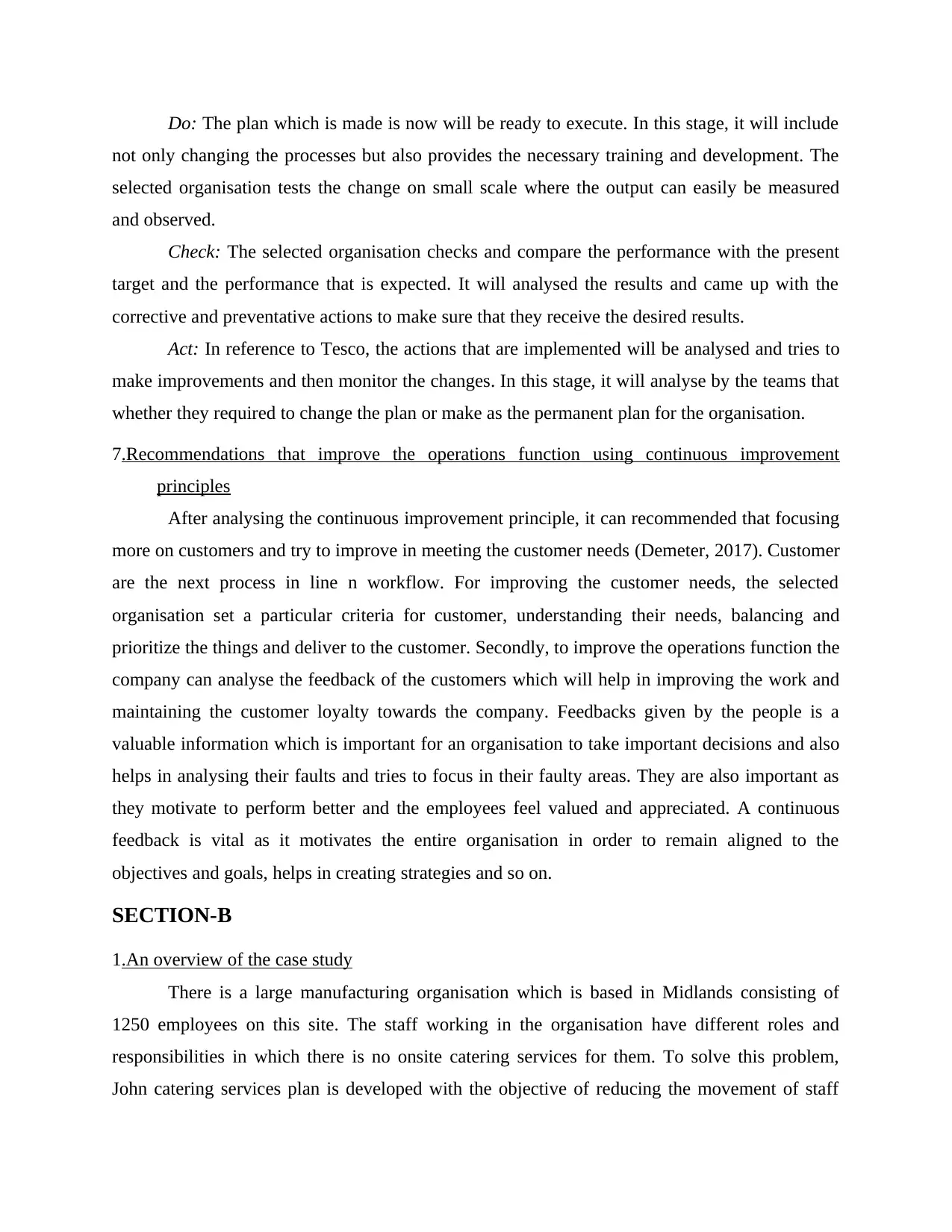
Do: The plan which is made is now will be ready to execute. In this stage, it will include
not only changing the processes but also provides the necessary training and development. The
selected organisation tests the change on small scale where the output can easily be measured
and observed.
Check: The selected organisation checks and compare the performance with the present
target and the performance that is expected. It will analysed the results and came up with the
corrective and preventative actions to make sure that they receive the desired results.
Act: In reference to Tesco, the actions that are implemented will be analysed and tries to
make improvements and then monitor the changes. In this stage, it will analyse by the teams that
whether they required to change the plan or make as the permanent plan for the organisation.
7.Recommendations that improve the operations function using continuous improvement
principles
After analysing the continuous improvement principle, it can recommended that focusing
more on customers and try to improve in meeting the customer needs (Demeter, 2017). Customer
are the next process in line n workflow. For improving the customer needs, the selected
organisation set a particular criteria for customer, understanding their needs, balancing and
prioritize the things and deliver to the customer. Secondly, to improve the operations function the
company can analyse the feedback of the customers which will help in improving the work and
maintaining the customer loyalty towards the company. Feedbacks given by the people is a
valuable information which is important for an organisation to take important decisions and also
helps in analysing their faults and tries to focus in their faulty areas. They are also important as
they motivate to perform better and the employees feel valued and appreciated. A continuous
feedback is vital as it motivates the entire organisation in order to remain aligned to the
objectives and goals, helps in creating strategies and so on.
SECTION-B
1.An overview of the case study
There is a large manufacturing organisation which is based in Midlands consisting of
1250 employees on this site. The staff working in the organisation have different roles and
responsibilities in which there is no onsite catering services for them. To solve this problem,
John catering services plan is developed with the objective of reducing the movement of staff
not only changing the processes but also provides the necessary training and development. The
selected organisation tests the change on small scale where the output can easily be measured
and observed.
Check: The selected organisation checks and compare the performance with the present
target and the performance that is expected. It will analysed the results and came up with the
corrective and preventative actions to make sure that they receive the desired results.
Act: In reference to Tesco, the actions that are implemented will be analysed and tries to
make improvements and then monitor the changes. In this stage, it will analyse by the teams that
whether they required to change the plan or make as the permanent plan for the organisation.
7.Recommendations that improve the operations function using continuous improvement
principles
After analysing the continuous improvement principle, it can recommended that focusing
more on customers and try to improve in meeting the customer needs (Demeter, 2017). Customer
are the next process in line n workflow. For improving the customer needs, the selected
organisation set a particular criteria for customer, understanding their needs, balancing and
prioritize the things and deliver to the customer. Secondly, to improve the operations function the
company can analyse the feedback of the customers which will help in improving the work and
maintaining the customer loyalty towards the company. Feedbacks given by the people is a
valuable information which is important for an organisation to take important decisions and also
helps in analysing their faults and tries to focus in their faulty areas. They are also important as
they motivate to perform better and the employees feel valued and appreciated. A continuous
feedback is vital as it motivates the entire organisation in order to remain aligned to the
objectives and goals, helps in creating strategies and so on.
SECTION-B
1.An overview of the case study
There is a large manufacturing organisation which is based in Midlands consisting of
1250 employees on this site. The staff working in the organisation have different roles and
responsibilities in which there is no onsite catering services for them. To solve this problem,
John catering services plan is developed with the objective of reducing the movement of staff

during lunch break which create congestion issues in local area and also helps staff in developing
healthy lifestyle in which CSR is part of organisation and also helps in reducing the staff
absenteeism. For implementing a strategic plan for the organisation, the catering service requires
a project life-cycle plan which is mentioned given below-
2.A description of the PLC and its stages
Project life-cycle is important as this framework designed to help project managers
guiding their projects from start to finish and it has purpose of creating easy to follow framework
to guide projects (Essila, 2019). In context to John catering services, they go through various
stages of project life cycle which is mentioned below-
Project initiation: It is the first stage where the client meet with stakeholders to
understand the goals, motivates them and hopes for the project. The catering services has an aim
which is to hash out the high level goals. They have to follow various steps for initiation such as
determining the project objectives, outlining the risks, establishment of scope and submitting a
proposal for project.
Project planning: After approval of the proposal, project planning is the next stage in
project life cycle. In reference to the selected organisation, the project plan includes translating
of proposal into series of actionable tasks and scheduling in the roadmap of the project, then
documenting the process that team will use, creating short term goals and addressing the issues.
Project execution: In context to John catering services, this stage is crucial as it is that
stage where the project is started to carry out all the tasks and activities that are mapped in the
planning stage. It includes the majority of project work that requires constant monitoring. The
manager of the selected company has the responsibilities of monitoring and controlling the
processes, adjusting and update the goals and objectives of the organisation and also
communicate between the team and project stakeholders.
Project closure: At this stage, the catering services analyse the results and summarizes
the key learning and plans its next step. The manager hand off all the deliverables, release its
team members and project resources and also analyse the project performance.
3.Business case
Project portfolio
Project portfolio includes all the information about various procedures that are utilised to
accomplish a certain project.
healthy lifestyle in which CSR is part of organisation and also helps in reducing the staff
absenteeism. For implementing a strategic plan for the organisation, the catering service requires
a project life-cycle plan which is mentioned given below-
2.A description of the PLC and its stages
Project life-cycle is important as this framework designed to help project managers
guiding their projects from start to finish and it has purpose of creating easy to follow framework
to guide projects (Essila, 2019). In context to John catering services, they go through various
stages of project life cycle which is mentioned below-
Project initiation: It is the first stage where the client meet with stakeholders to
understand the goals, motivates them and hopes for the project. The catering services has an aim
which is to hash out the high level goals. They have to follow various steps for initiation such as
determining the project objectives, outlining the risks, establishment of scope and submitting a
proposal for project.
Project planning: After approval of the proposal, project planning is the next stage in
project life cycle. In reference to the selected organisation, the project plan includes translating
of proposal into series of actionable tasks and scheduling in the roadmap of the project, then
documenting the process that team will use, creating short term goals and addressing the issues.
Project execution: In context to John catering services, this stage is crucial as it is that
stage where the project is started to carry out all the tasks and activities that are mapped in the
planning stage. It includes the majority of project work that requires constant monitoring. The
manager of the selected company has the responsibilities of monitoring and controlling the
processes, adjusting and update the goals and objectives of the organisation and also
communicate between the team and project stakeholders.
Project closure: At this stage, the catering services analyse the results and summarizes
the key learning and plans its next step. The manager hand off all the deliverables, release its
team members and project resources and also analyse the project performance.
3.Business case
Project portfolio
Project portfolio includes all the information about various procedures that are utilised to
accomplish a certain project.
Paraphrase This Document
Need a fresh take? Get an instant paraphrase of this document with our AI Paraphraser
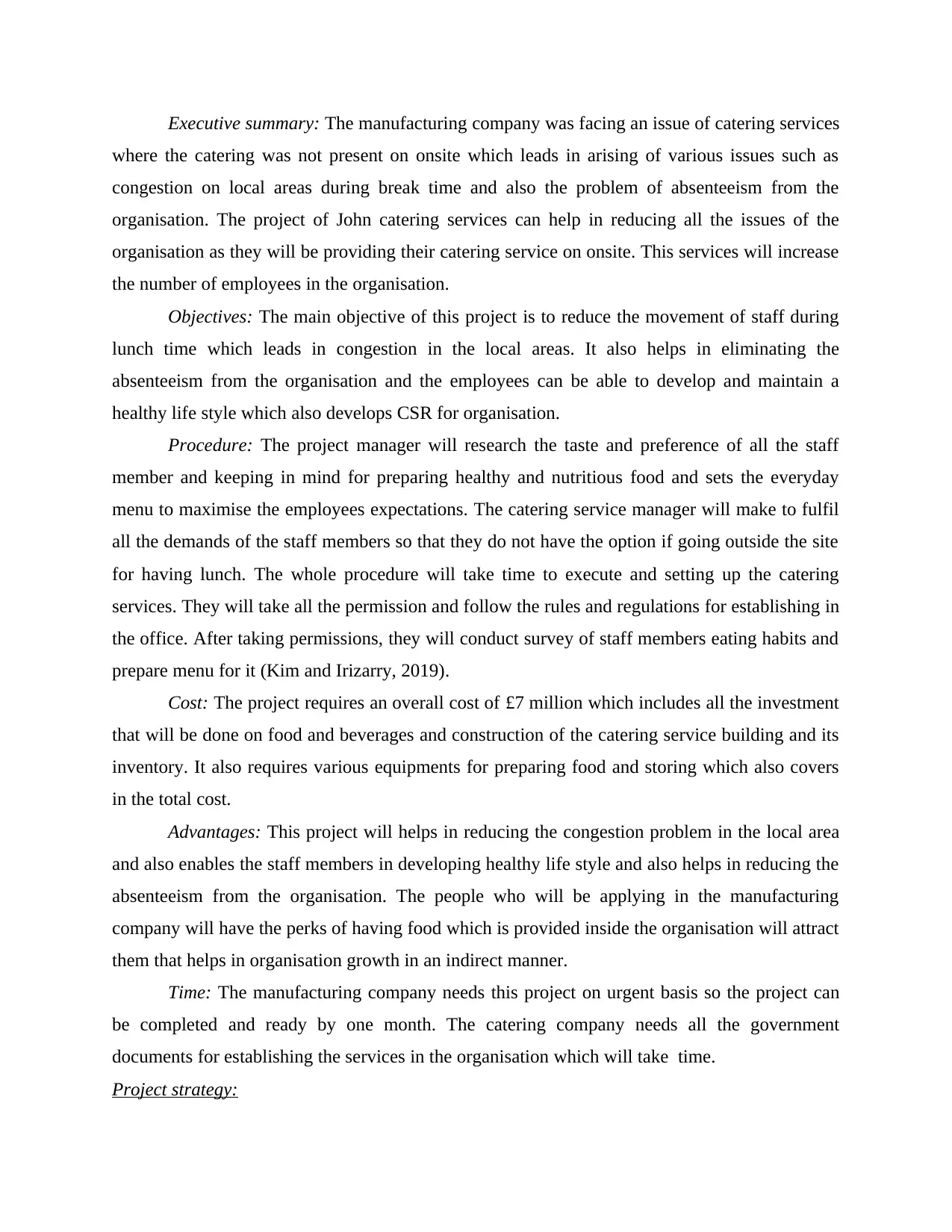
Executive summary: The manufacturing company was facing an issue of catering services
where the catering was not present on onsite which leads in arising of various issues such as
congestion on local areas during break time and also the problem of absenteeism from the
organisation. The project of John catering services can help in reducing all the issues of the
organisation as they will be providing their catering service on onsite. This services will increase
the number of employees in the organisation.
Objectives: The main objective of this project is to reduce the movement of staff during
lunch time which leads in congestion in the local areas. It also helps in eliminating the
absenteeism from the organisation and the employees can be able to develop and maintain a
healthy life style which also develops CSR for organisation.
Procedure: The project manager will research the taste and preference of all the staff
member and keeping in mind for preparing healthy and nutritious food and sets the everyday
menu to maximise the employees expectations. The catering service manager will make to fulfil
all the demands of the staff members so that they do not have the option if going outside the site
for having lunch. The whole procedure will take time to execute and setting up the catering
services. They will take all the permission and follow the rules and regulations for establishing in
the office. After taking permissions, they will conduct survey of staff members eating habits and
prepare menu for it (Kim and Irizarry, 2019).
Cost: The project requires an overall cost of £7 million which includes all the investment
that will be done on food and beverages and construction of the catering service building and its
inventory. It also requires various equipments for preparing food and storing which also covers
in the total cost.
Advantages: This project will helps in reducing the congestion problem in the local area
and also enables the staff members in developing healthy life style and also helps in reducing the
absenteeism from the organisation. The people who will be applying in the manufacturing
company will have the perks of having food which is provided inside the organisation will attract
them that helps in organisation growth in an indirect manner.
Time: The manufacturing company needs this project on urgent basis so the project can
be completed and ready by one month. The catering company needs all the government
documents for establishing the services in the organisation which will take time.
Project strategy:
where the catering was not present on onsite which leads in arising of various issues such as
congestion on local areas during break time and also the problem of absenteeism from the
organisation. The project of John catering services can help in reducing all the issues of the
organisation as they will be providing their catering service on onsite. This services will increase
the number of employees in the organisation.
Objectives: The main objective of this project is to reduce the movement of staff during
lunch time which leads in congestion in the local areas. It also helps in eliminating the
absenteeism from the organisation and the employees can be able to develop and maintain a
healthy life style which also develops CSR for organisation.
Procedure: The project manager will research the taste and preference of all the staff
member and keeping in mind for preparing healthy and nutritious food and sets the everyday
menu to maximise the employees expectations. The catering service manager will make to fulfil
all the demands of the staff members so that they do not have the option if going outside the site
for having lunch. The whole procedure will take time to execute and setting up the catering
services. They will take all the permission and follow the rules and regulations for establishing in
the office. After taking permissions, they will conduct survey of staff members eating habits and
prepare menu for it (Kim and Irizarry, 2019).
Cost: The project requires an overall cost of £7 million which includes all the investment
that will be done on food and beverages and construction of the catering service building and its
inventory. It also requires various equipments for preparing food and storing which also covers
in the total cost.
Advantages: This project will helps in reducing the congestion problem in the local area
and also enables the staff members in developing healthy life style and also helps in reducing the
absenteeism from the organisation. The people who will be applying in the manufacturing
company will have the perks of having food which is provided inside the organisation will attract
them that helps in organisation growth in an indirect manner.
Time: The manufacturing company needs this project on urgent basis so the project can
be completed and ready by one month. The catering company needs all the government
documents for establishing the services in the organisation which will take time.
Project strategy:
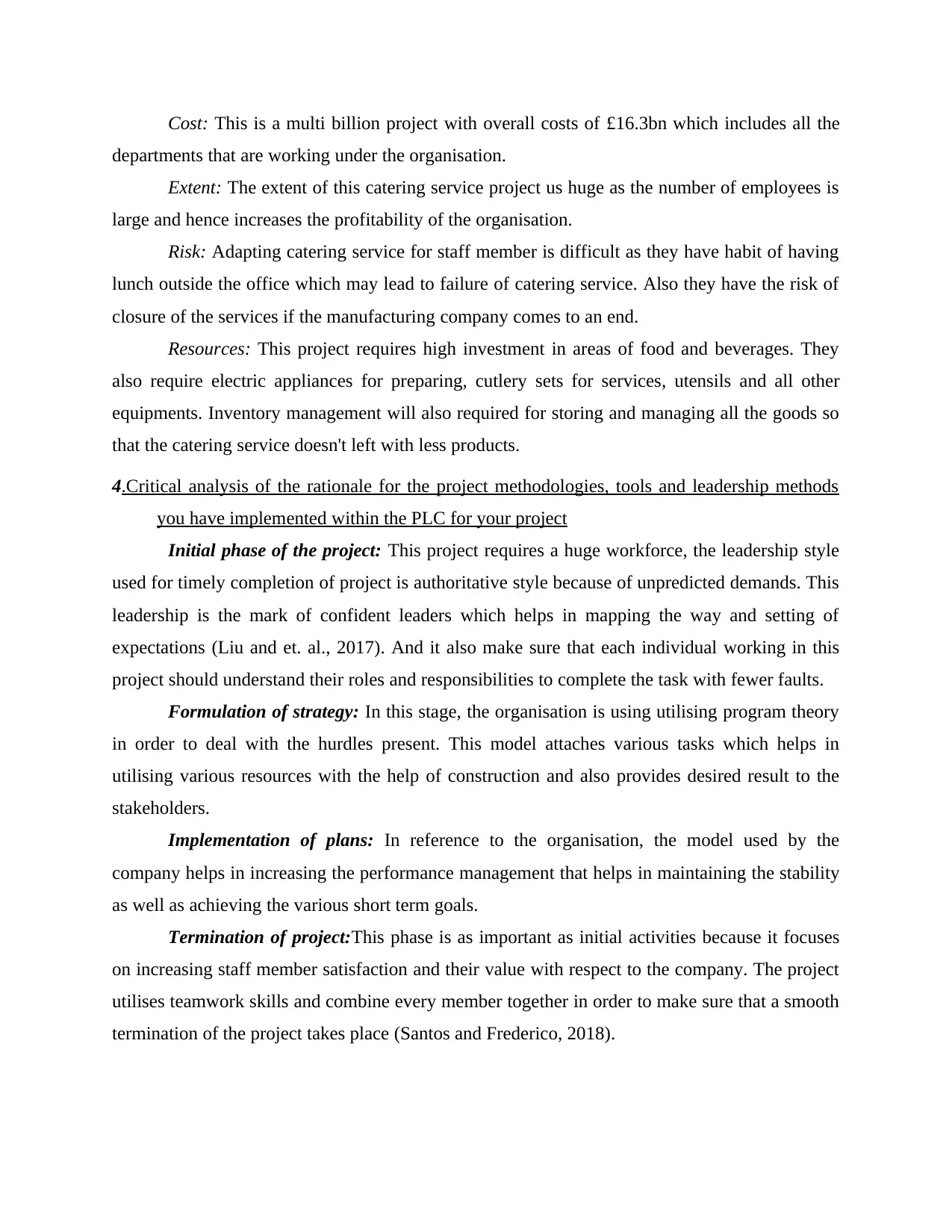
Cost: This is a multi billion project with overall costs of £16.3bn which includes all the
departments that are working under the organisation.
Extent: The extent of this catering service project us huge as the number of employees is
large and hence increases the profitability of the organisation.
Risk: Adapting catering service for staff member is difficult as they have habit of having
lunch outside the office which may lead to failure of catering service. Also they have the risk of
closure of the services if the manufacturing company comes to an end.
Resources: This project requires high investment in areas of food and beverages. They
also require electric appliances for preparing, cutlery sets for services, utensils and all other
equipments. Inventory management will also required for storing and managing all the goods so
that the catering service doesn't left with less products.
4.Critical analysis of the rationale for the project methodologies, tools and leadership methods
you have implemented within the PLC for your project
Initial phase of the project: This project requires a huge workforce, the leadership style
used for timely completion of project is authoritative style because of unpredicted demands. This
leadership is the mark of confident leaders which helps in mapping the way and setting of
expectations (Liu and et. al., 2017). And it also make sure that each individual working in this
project should understand their roles and responsibilities to complete the task with fewer faults.
Formulation of strategy: In this stage, the organisation is using utilising program theory
in order to deal with the hurdles present. This model attaches various tasks which helps in
utilising various resources with the help of construction and also provides desired result to the
stakeholders.
Implementation of plans: In reference to the organisation, the model used by the
company helps in increasing the performance management that helps in maintaining the stability
as well as achieving the various short term goals.
Termination of project:This phase is as important as initial activities because it focuses
on increasing staff member satisfaction and their value with respect to the company. The project
utilises teamwork skills and combine every member together in order to make sure that a smooth
termination of the project takes place (Santos and Frederico, 2018).
departments that are working under the organisation.
Extent: The extent of this catering service project us huge as the number of employees is
large and hence increases the profitability of the organisation.
Risk: Adapting catering service for staff member is difficult as they have habit of having
lunch outside the office which may lead to failure of catering service. Also they have the risk of
closure of the services if the manufacturing company comes to an end.
Resources: This project requires high investment in areas of food and beverages. They
also require electric appliances for preparing, cutlery sets for services, utensils and all other
equipments. Inventory management will also required for storing and managing all the goods so
that the catering service doesn't left with less products.
4.Critical analysis of the rationale for the project methodologies, tools and leadership methods
you have implemented within the PLC for your project
Initial phase of the project: This project requires a huge workforce, the leadership style
used for timely completion of project is authoritative style because of unpredicted demands. This
leadership is the mark of confident leaders which helps in mapping the way and setting of
expectations (Liu and et. al., 2017). And it also make sure that each individual working in this
project should understand their roles and responsibilities to complete the task with fewer faults.
Formulation of strategy: In this stage, the organisation is using utilising program theory
in order to deal with the hurdles present. This model attaches various tasks which helps in
utilising various resources with the help of construction and also provides desired result to the
stakeholders.
Implementation of plans: In reference to the organisation, the model used by the
company helps in increasing the performance management that helps in maintaining the stability
as well as achieving the various short term goals.
Termination of project:This phase is as important as initial activities because it focuses
on increasing staff member satisfaction and their value with respect to the company. The project
utilises teamwork skills and combine every member together in order to make sure that a smooth
termination of the project takes place (Santos and Frederico, 2018).
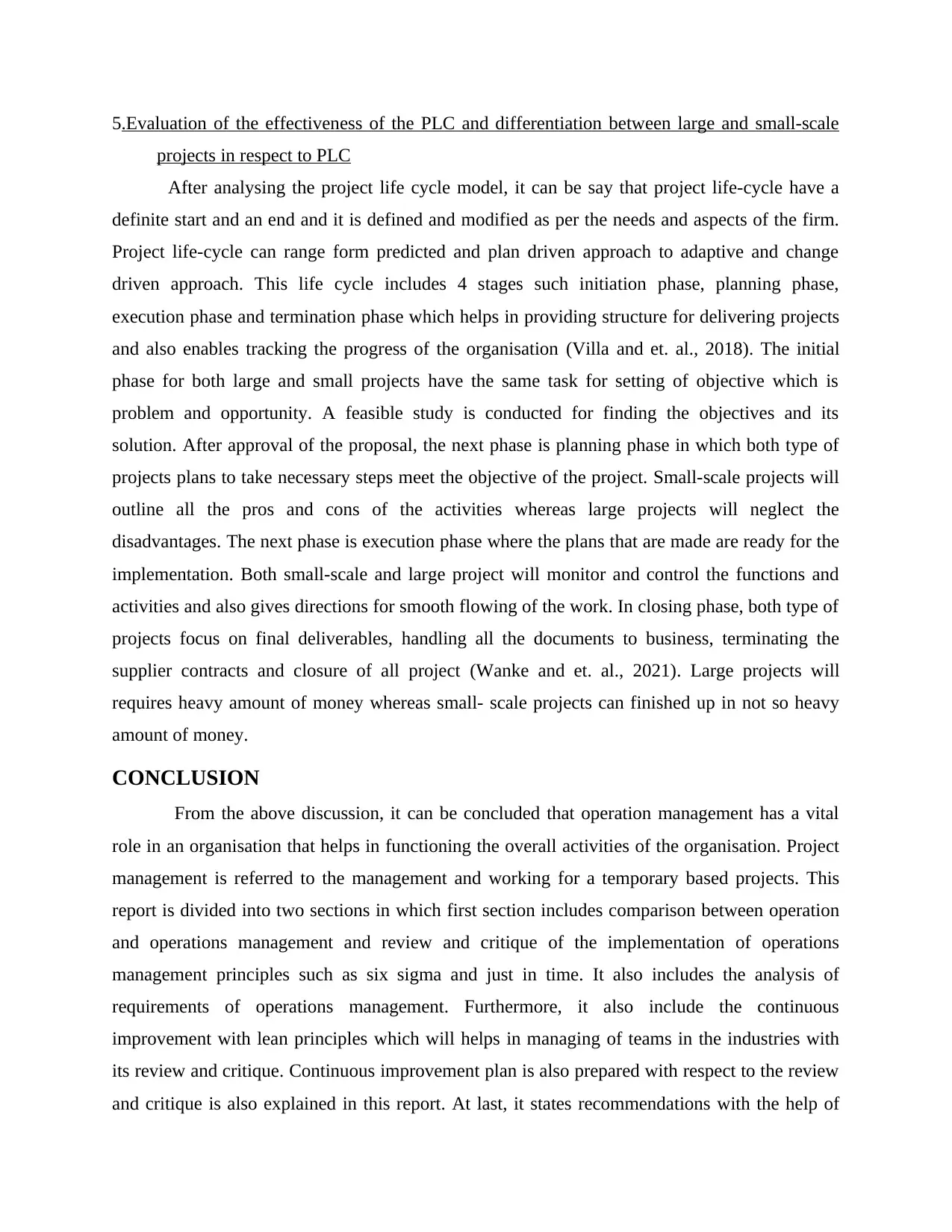
5.Evaluation of the effectiveness of the PLC and differentiation between large and small-scale
projects in respect to PLC
After analysing the project life cycle model, it can be say that project life-cycle have a
definite start and an end and it is defined and modified as per the needs and aspects of the firm.
Project life-cycle can range form predicted and plan driven approach to adaptive and change
driven approach. This life cycle includes 4 stages such initiation phase, planning phase,
execution phase and termination phase which helps in providing structure for delivering projects
and also enables tracking the progress of the organisation (Villa and et. al., 2018). The initial
phase for both large and small projects have the same task for setting of objective which is
problem and opportunity. A feasible study is conducted for finding the objectives and its
solution. After approval of the proposal, the next phase is planning phase in which both type of
projects plans to take necessary steps meet the objective of the project. Small-scale projects will
outline all the pros and cons of the activities whereas large projects will neglect the
disadvantages. The next phase is execution phase where the plans that are made are ready for the
implementation. Both small-scale and large project will monitor and control the functions and
activities and also gives directions for smooth flowing of the work. In closing phase, both type of
projects focus on final deliverables, handling all the documents to business, terminating the
supplier contracts and closure of all project (Wanke and et. al., 2021). Large projects will
requires heavy amount of money whereas small- scale projects can finished up in not so heavy
amount of money.
CONCLUSION
From the above discussion, it can be concluded that operation management has a vital
role in an organisation that helps in functioning the overall activities of the organisation. Project
management is referred to the management and working for a temporary based projects. This
report is divided into two sections in which first section includes comparison between operation
and operations management and review and critique of the implementation of operations
management principles such as six sigma and just in time. It also includes the analysis of
requirements of operations management. Furthermore, it also include the continuous
improvement with lean principles which will helps in managing of teams in the industries with
its review and critique. Continuous improvement plan is also prepared with respect to the review
and critique is also explained in this report. At last, it states recommendations with the help of
projects in respect to PLC
After analysing the project life cycle model, it can be say that project life-cycle have a
definite start and an end and it is defined and modified as per the needs and aspects of the firm.
Project life-cycle can range form predicted and plan driven approach to adaptive and change
driven approach. This life cycle includes 4 stages such initiation phase, planning phase,
execution phase and termination phase which helps in providing structure for delivering projects
and also enables tracking the progress of the organisation (Villa and et. al., 2018). The initial
phase for both large and small projects have the same task for setting of objective which is
problem and opportunity. A feasible study is conducted for finding the objectives and its
solution. After approval of the proposal, the next phase is planning phase in which both type of
projects plans to take necessary steps meet the objective of the project. Small-scale projects will
outline all the pros and cons of the activities whereas large projects will neglect the
disadvantages. The next phase is execution phase where the plans that are made are ready for the
implementation. Both small-scale and large project will monitor and control the functions and
activities and also gives directions for smooth flowing of the work. In closing phase, both type of
projects focus on final deliverables, handling all the documents to business, terminating the
supplier contracts and closure of all project (Wanke and et. al., 2021). Large projects will
requires heavy amount of money whereas small- scale projects can finished up in not so heavy
amount of money.
CONCLUSION
From the above discussion, it can be concluded that operation management has a vital
role in an organisation that helps in functioning the overall activities of the organisation. Project
management is referred to the management and working for a temporary based projects. This
report is divided into two sections in which first section includes comparison between operation
and operations management and review and critique of the implementation of operations
management principles such as six sigma and just in time. It also includes the analysis of
requirements of operations management. Furthermore, it also include the continuous
improvement with lean principles which will helps in managing of teams in the industries with
its review and critique. Continuous improvement plan is also prepared with respect to the review
and critique is also explained in this report. At last, it states recommendations with the help of
Secure Best Marks with AI Grader
Need help grading? Try our AI Grader for instant feedback on your assignments.
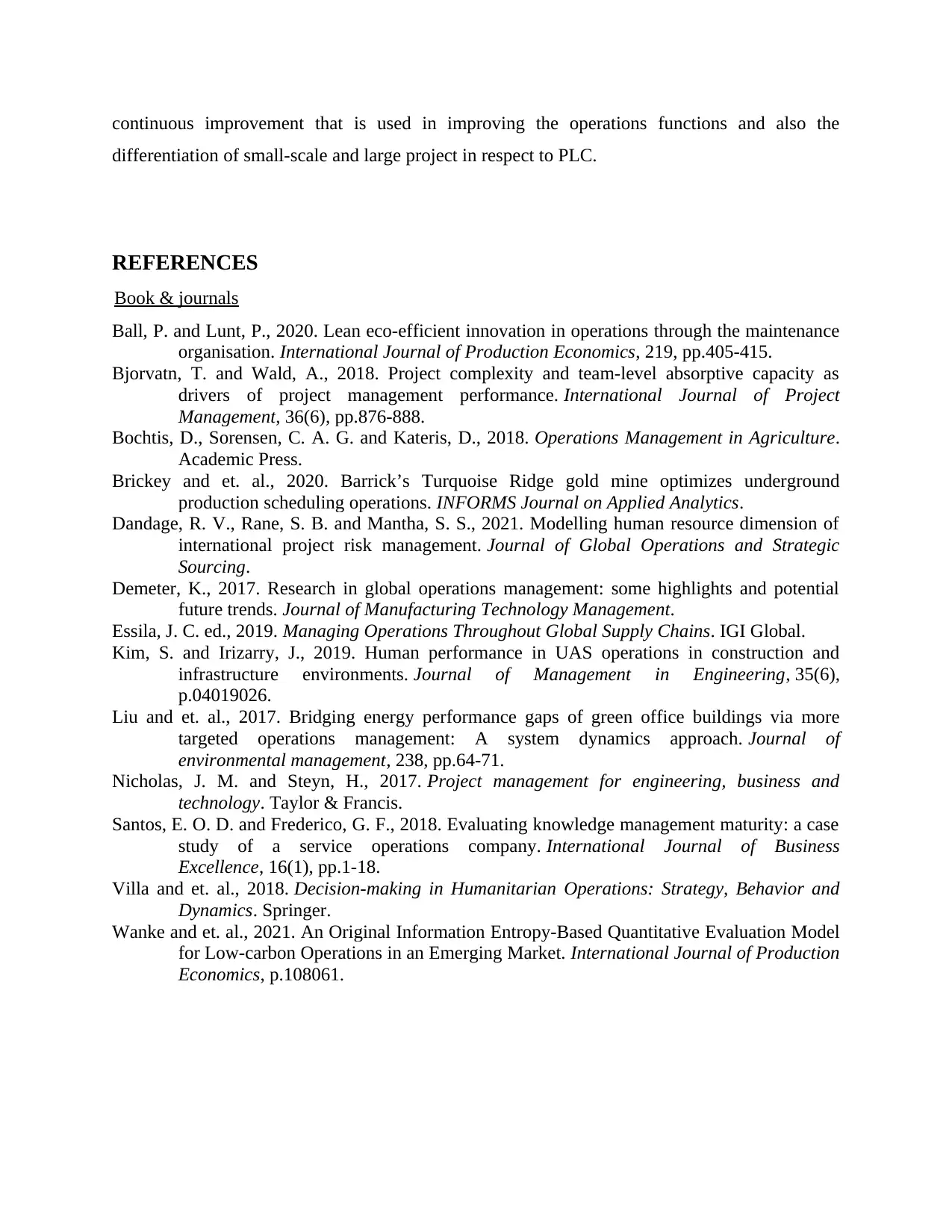
continuous improvement that is used in improving the operations functions and also the
differentiation of small-scale and large project in respect to PLC.
REFERENCES
Book & journals
Ball, P. and Lunt, P., 2020. Lean eco-efficient innovation in operations through the maintenance
organisation. International Journal of Production Economics, 219, pp.405-415.
Bjorvatn, T. and Wald, A., 2018. Project complexity and team-level absorptive capacity as
drivers of project management performance. International Journal of Project
Management, 36(6), pp.876-888.
Bochtis, D., Sorensen, C. A. G. and Kateris, D., 2018. Operations Management in Agriculture.
Academic Press.
Brickey and et. al., 2020. Barrick’s Turquoise Ridge gold mine optimizes underground
production scheduling operations. INFORMS Journal on Applied Analytics.
Dandage, R. V., Rane, S. B. and Mantha, S. S., 2021. Modelling human resource dimension of
international project risk management. Journal of Global Operations and Strategic
Sourcing.
Demeter, K., 2017. Research in global operations management: some highlights and potential
future trends. Journal of Manufacturing Technology Management.
Essila, J. C. ed., 2019. Managing Operations Throughout Global Supply Chains. IGI Global.
Kim, S. and Irizarry, J., 2019. Human performance in UAS operations in construction and
infrastructure environments. Journal of Management in Engineering, 35(6),
p.04019026.
Liu and et. al., 2017. Bridging energy performance gaps of green office buildings via more
targeted operations management: A system dynamics approach. Journal of
environmental management, 238, pp.64-71.
Nicholas, J. M. and Steyn, H., 2017. Project management for engineering, business and
technology. Taylor & Francis.
Santos, E. O. D. and Frederico, G. F., 2018. Evaluating knowledge management maturity: a case
study of a service operations company. International Journal of Business
Excellence, 16(1), pp.1-18.
Villa and et. al., 2018. Decision-making in Humanitarian Operations: Strategy, Behavior and
Dynamics. Springer.
Wanke and et. al., 2021. An Original Information Entropy-Based Quantitative Evaluation Model
for Low-carbon Operations in an Emerging Market. International Journal of Production
Economics, p.108061.
differentiation of small-scale and large project in respect to PLC.
REFERENCES
Book & journals
Ball, P. and Lunt, P., 2020. Lean eco-efficient innovation in operations through the maintenance
organisation. International Journal of Production Economics, 219, pp.405-415.
Bjorvatn, T. and Wald, A., 2018. Project complexity and team-level absorptive capacity as
drivers of project management performance. International Journal of Project
Management, 36(6), pp.876-888.
Bochtis, D., Sorensen, C. A. G. and Kateris, D., 2018. Operations Management in Agriculture.
Academic Press.
Brickey and et. al., 2020. Barrick’s Turquoise Ridge gold mine optimizes underground
production scheduling operations. INFORMS Journal on Applied Analytics.
Dandage, R. V., Rane, S. B. and Mantha, S. S., 2021. Modelling human resource dimension of
international project risk management. Journal of Global Operations and Strategic
Sourcing.
Demeter, K., 2017. Research in global operations management: some highlights and potential
future trends. Journal of Manufacturing Technology Management.
Essila, J. C. ed., 2019. Managing Operations Throughout Global Supply Chains. IGI Global.
Kim, S. and Irizarry, J., 2019. Human performance in UAS operations in construction and
infrastructure environments. Journal of Management in Engineering, 35(6),
p.04019026.
Liu and et. al., 2017. Bridging energy performance gaps of green office buildings via more
targeted operations management: A system dynamics approach. Journal of
environmental management, 238, pp.64-71.
Nicholas, J. M. and Steyn, H., 2017. Project management for engineering, business and
technology. Taylor & Francis.
Santos, E. O. D. and Frederico, G. F., 2018. Evaluating knowledge management maturity: a case
study of a service operations company. International Journal of Business
Excellence, 16(1), pp.1-18.
Villa and et. al., 2018. Decision-making in Humanitarian Operations: Strategy, Behavior and
Dynamics. Springer.
Wanke and et. al., 2021. An Original Information Entropy-Based Quantitative Evaluation Model
for Low-carbon Operations in an Emerging Market. International Journal of Production
Economics, p.108061.

1 out of 12
Related Documents
Your All-in-One AI-Powered Toolkit for Academic Success.
+13062052269
info@desklib.com
Available 24*7 on WhatsApp / Email
![[object Object]](/_next/static/media/star-bottom.7253800d.svg)
Unlock your academic potential
© 2024 | Zucol Services PVT LTD | All rights reserved.


